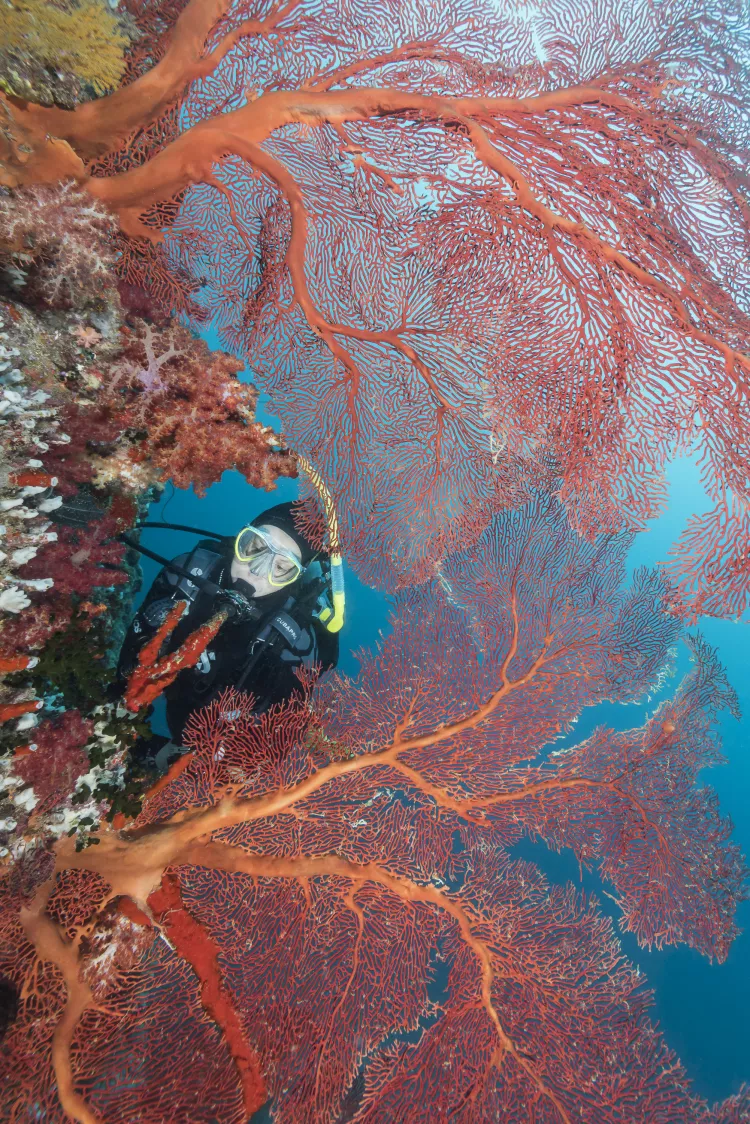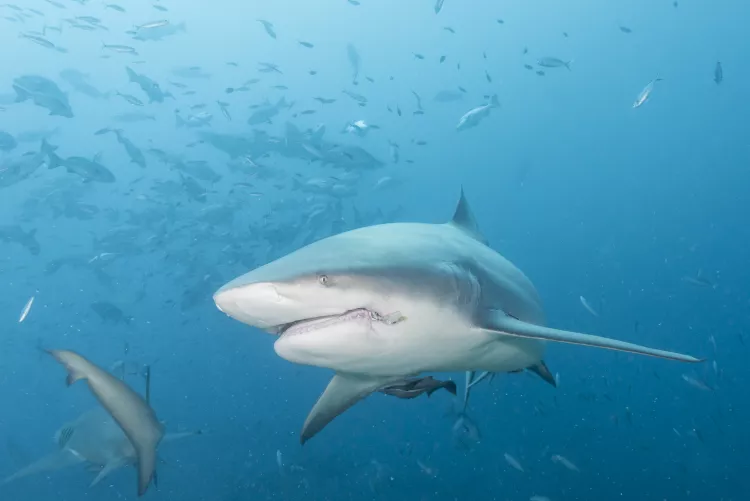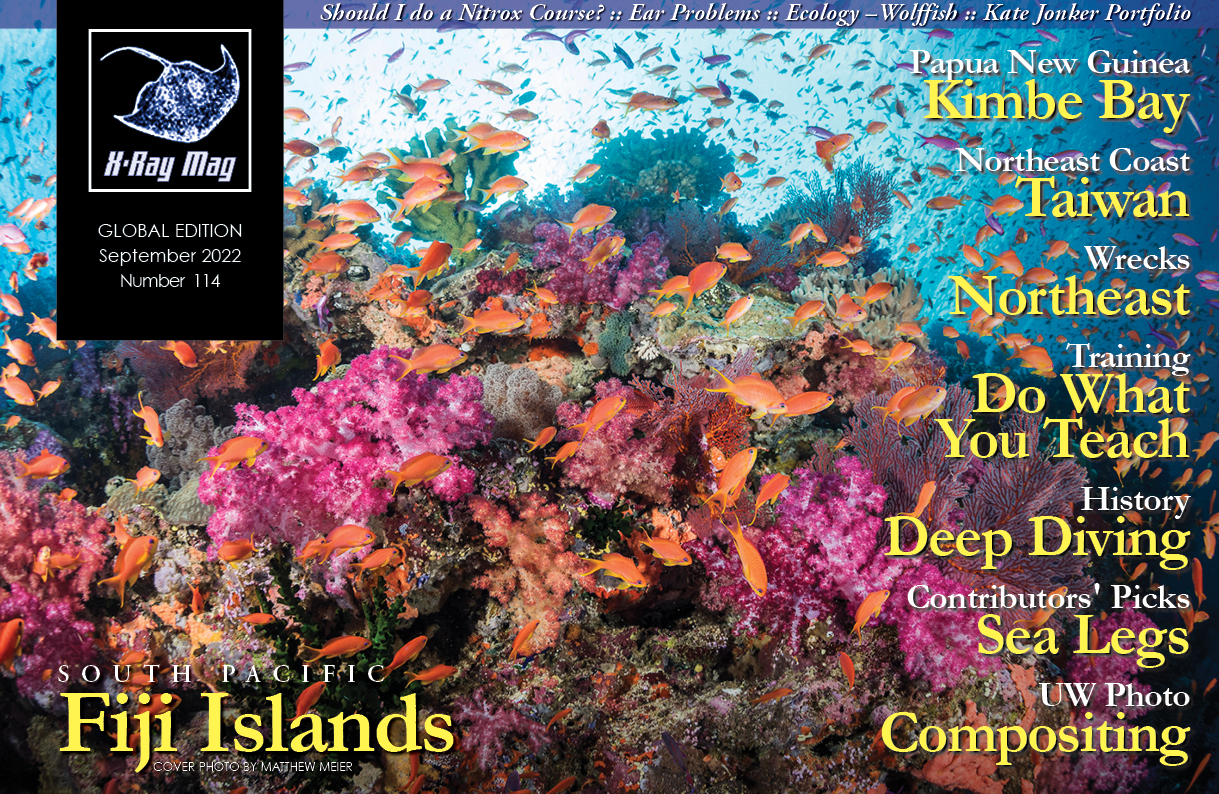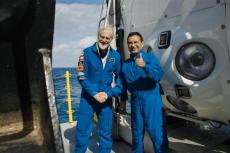Bula! Fiji is open, and some of the friendliest people in the South Pacific are eager to welcome you back to their tropical oasis. Matthew Meier has the story.
Contributed by
I have been fortunate to visit Fiji in years past, and it is one of the few dive destinations that I have returned to on multiple occasions. The country’s amazingly colorful coral reefs, abundant fish life and beautiful landscapes, as well as the warmth and caring of the Fijian people, keep me coming back. I look forward to revisiting favorite dive sites, exploring those yet unknown and embarking on adventures alongside friends old and new. This is a country steeped in tradition and culture that I could move to tomorrow and feel right at home.
The island nation of Fiji officially re-opened its borders to fully vaccinated travelers on 1 December 2021, and I was privileged to make an extended visit in early March. For more than a year, during the height of the pandemic, Fiji was off limits to foreign travelers and the country even restricted inner island travel for residents to help minimize the spread of the virus. While I was there, the country was upwards of 94% vaccinated, counting 100% of employees in tourist-related jobs.

Viti Levu Island
The first stop on our epic adventure was to the northern shores of Viti Levu Island to dive the fabled Bligh Waters. Named for Lieutenant William Bligh of the English Royal Navy who, along with 18 loyal crew members, sailed through these seas in 1789 on a 23ft (7m) launch, cast adrift following the infamous Mutiny on the Bounty. Bligh and his sailors ultimately survived the ordeal, traveling more than 3,600 nautical miles before safely coming ashore in Timor, Indonesia.
Winter months in the northern hemisphere equate to summer in Fiji, which comprises warm, humid and sometimes windy topside conditions, the occasional scattered thunderstorm and water temperatures in the low 80s. Visibility can be affected by particulate matter caused by rain run-off and the churning of the ocean from passing storms but it still exceeded a gratifying 60ft on most of my dives—slightly less than the 100+ feet of visibility I had experienced during previous July and August visits but a massive improvement on the 5 to 15ft I am accustomed to in California.

Fiji has been dubbed the soft coral capital of the world, and many of the iconic dive sites within the Bligh Waters substantiate that moniker. We had the pleasure of diving sites such as Mount Mutiny, Purple Haze, Vatu Express, Maytag, G6, Instant Replay and, one of my personal favorites, Mellow Yellow. As the name implies, magnificent golden soft corals blanket its two submerged pinnacles while contrasting red and purple sea fans and green sun coral formations break up the scene and provide shelter for aggregations of vibrant reef fish.
Most of these sites lay within the 42 sq mi (110 sq km) Vatu-i-Ra Conservation Park, which was established in 2017 as a means of protecting the park’s abundant biodiversity. Visitors are charged a FJ$15 annual fee, which helps sustain the park’s management and also contributes to an education fund for children of the local Nakorotubu District.
Vatu Island. Vatu Island, or “bird island” as it is known, is located at the northern end of the park and supports notable colonies of seabirds as well as serves as a nesting site for hawksbill sea turtles. On a three-tank dive day, when the tide cooperates, divers can spend their after-lunch surface interval walking on the sand at Vatu Island surrounded by hundreds of terns, gulls and frigate birds.
Alternating two- and three-tank dive days, we departed the resort each morning for a 30- to 40-minute transit out to our first dive site. The commute afforded conversation to get to know our fellow divers and also time to leisurely gear up before having to hit the water.
Maytag. On this particular two-tank morning, we first dropped into Maytag, named for the occasional washing-machine-type movement of the water possible here, and were rewarded with a steady drift and several large sea fans exploding with fish life. The current was such that I was able to kick into it, maintaining position, while doing my best to let the fish get used to my presence, so as to time my shots with their synchronized movements.

Instant Replay. After everyone was back on the boat, the captain moved us farther down the reef for dive number two at a site called Instant Replay. Following our guide, we floated past several coral bommies adorned with stunning sea fans and radiant soft corals that were swarming with fish. During our safety stop, I was captivated by the electric hot pink soft corals near the top of the reef, which were smothered with schooling orange-colored anthias and purple fusiliers. It was a spectacular morning that encapsulated part of why I keep coming back to Fiji.
Soft corals sustain themselves on passing food particles. When the current is running, they inflate their bodies with water to maximize surface area, thereby increasing their chances of catching a meal.
Successfully diving soft coral is all about the current. The trick for the dive operator is to find a dive site with enough current to open up the corals but not so much current that divers are whisked away without a chance to appreciate, much less photograph, the scene. It is a delicate balance of timing that requires close attention to the tides, the evaluation of conditions once onsite and, of course, years of experience.
During the pandemic when the resort was empty and boats were shuttered to save on fuel, one of the owners and his now 12-year-old daughter made over 100 shore dives to pass the time and advance her dive qualifications. What they discovered was a whole new world of muck diving and dozens of new macro critters they never knew existed.
I made a check-out dive upon my arrival, and in just 30 minutes, I saw multiple pipefish, shrimp gobies, clownfish in anemones, juvenile filefish, brilliant tube worms and one very shy yellow seahorse. Fiji will forever be known for its phenomenal coral reefs, but it is always nice to have other options, and I think a little critter-hunting in the muck is a great way to spend the afternoon and perhaps practice your macro photography.

Fijian dance, music & song
One evening, we were treated to a meke and lovo dinner down by the beach. Meke is a mingling of traditional Fijian dance, music and song used for the telling of stories. Male dancers are typically dressed as warriors, carrying spears or clubs, while the women often perform a fan dance in traditional skirts. The musicians maintain a steady beat for the dancers and are frequently seated on mats in the background.
Lovo is a celebratory meal reserved for special occasions in Fijian culture and also refers to the underground oven used to cook the feast. Meat, chicken, fish and pork, along with various root vegetables, are wrapped in banana leaves and palm fronds before being roasted for hours over hot coals and stones placed in the earth. The food is delicious, and the cultural experience is not to be missed.
After the dinner and dancing, we were invited to share in a kava ceremony. Kava is a traditional Fijian drink made from the root of the yaqona plant which can elicit a euphoric, calming feeling. It is customarily consumed during greetings, gatherings and offered as a sign of respect when visiting a neighboring village. The root is dried and crushed, before being placed in a cheesecloth and mixed with water in a communal wooden bowl, creating a brown, muddy concoction.
The peppery liquid is then imbibed from a half-coconut shell, ideally in a single gulp, often leaving the lips, mouth and tongue a bit numb. Participants sit around the bowl and take turns drinking as the coconut shell is ceremoniously passed around the circle. Not exclusively used for special occasions, the kava ritual is part of daily life for many Fijians.
Bidding goodbye to the Bligh Waters, we traveled around the eastern half of the island on the Kings Highway past Suva, the nation’s capital, to Pacific Harbor. Intermittent rain showers occasionally limited our driver’s visibility, making for quite a memorable journey.

Coral Coast
When we finally arrived at the island’s southern perimeter, known as the Coral Coast, we found our new home situated at the water’s edge, on its own private inlet and surrounded by remote tropical jungle. The picturesque, secluded grounds conveyed an immediate sense of peace and tranquility.
Beqa Lagoon. A majority of the scuba diving on the southern coastline occurs within the confines of Beqa Lagoon, which is protected by a sizable offshore barrier reef. The underwater topography is striking—predominantly comprised of pinnacles, bommies and walls punctuated with hard corals, sea fans and, somewhat less frequently than the Bligh Waters, soft corals. The branching hard corals attract a variety of reef fish, which pulse into the water column in search of food before any perceived threat triggers a coordinated retreat to the safety of their maze-like homes.
7 Sisters / TASU II wreck. Our first day on the water was a three-tank dive starting with the TASU II shipwreck at a site called 7 Sisters. In addition to its seven namesake pinnacles covered in hard corals and sea fans, the former 200-ton Taiwanese fishing vessel was interesting to circumnavigate, sitting upright on the sandy bottom, encrusted with marine life.
3 Nuns. Even larger sea fans awaited us at a site called 3 Nuns for our second dive before we were treated to a delectable picnic lunch on the beach at Yanuca Island. Ringed by shallow coral reefs, the infrastructure of an abandoned surf resort is all that remains on this beautiful uninhabited sanctuary.
Golden Arch. At our final dive site, appropriately named Golden Arch, we discovered a large swim-through, capable of enveloping multiple divers, extensively cloaked in yellow soft corals. Several smaller arches in the rocky terrain provided a wider array of gaudy soft corals, along with a myriad of sea rods, sponges and sea fans to round out a great day of diving.
Navua River & Sabata Village

An inner-tube float down the Navua River was on the agenda for the following day, starting off with a 13.7-mile (22km) journey upriver, past numerous waterfalls and small sets of rapids, in long wooden canoes. Our eventual destination was the village of Sabata where we met a few of the local residents and learned about traditional Fijian life.
The 50+ inhabitants survive off the land without electricity or running water. Fish and freshwater eels are plucked from the river; pigs and chickens are raised for food; and taro, cassava and other vegetables, along with kava plants, are cultivated on the surrounding hillsides.
During our visit, we witnessed kava root drying in the sun and several huts filled with woven mats at various stages of completion. The mats, which are frequently gifted for special occasions, have immense cultural value and are often the only furniture found in a Fijian home.
Waterfall hike
After the village tour, we embarked on a waterfall hike culminating with a revitalizing and welcome dip in the cool water pool at its base. Lunch in the shade along the shoreline followed, and then it was time to don life vests and clamber onto our inner tubes for a refreshing float back downstream.
It was relaxing to slowly travel past the steep canyon walls, and at times invigorating, as we navigated the gentle rapids. Thankfully, the guides helped control our descent through the more sizable waves, leaving very little for us to do but enjoy the ride.
Coral Coast activities
The coral coast may as well also be known as the adventure coast. In addition to river tubing, guests can partake in river rafting, jet boat safaris, cave tours, waterfall hikes, jet skiing, dune buggy treks, zip lining, sky diving, cultural tours, wildlife park excursions, golf outings, paddle boarding, surfing and shark diving. Additionally, on the grounds of the resort, we had access to a slackline, volleyball, a swimming pool, jungle hikes, kayaks, stand-up paddle boards, yoga, darts and a pool table.

Pacific Harbor shark diving
The shark diving in Pacific Harbor is world-renowned and excitement levels were high as we pushed off from the dock for a two-tank dive. After tying up to the mooring line, we were briefed on what to expect and how to behave underwater.
Submerging to 60ft (18m), the group knelt in an arc behind a short rock wall as numerous sharks circled the bait canisters suspended in front of us. Several healthy bull sharks made their presence known, while a lemon shark, with golden trevally escorts, paid particular attention to my strobes, as nurse, reef and blacktip sharks stayed close by in hopes of a free meal. After 20 to 30 minutes of steady activity, the sharks were rewarded with the contents of the bait box as we ascended to shallower depths to inspect the surrounding coral reef and an inverted shipwreck.
Animated voices filled the air back onboard as we recounted our exhilarating experiences, and after a surface interval, we were all psyched to get back in with the sharks for round two. I had hoped one of the semi-resident tiger sharks would make our acquaintance, but alas, she did not materialize. As a sort of consolation prize, a dive guide presented me with a couple of shark teeth found on the bottom after the bait was devoured.

More Coral Coast diving
Caesar’s Rock. Still pumped with elevated serotonin levels from our adrenaline-filled morning, we stopped at a site called Caesar’s Rock to explore its pinnacles and sea-fan-filled swim-throughs. I was fascinated to examine the various caverns cut into the site’s five pinnacles, but the highlight for me was the bountiful fish life oscillating above the healthy hard corals near the surface. I spent the second half of the dive and my entire safety stop looking for fish-filled photo ops.
Frigates. Our second temporary home was as much a surf resort as it was a dive resort, and on our final day on the water, we made the trek out to the famous surf break Frigates to dive the barrier reef, which gives life to its standing waves. We were joined by the resort’s surfing guide, so I could also attempt to photograph him in action.
A weather system had rolled in overnight and the flat calm seas from the previous day were replaced with a steady chop and gusty winds. Not ideal for surfing or diving, but with an hour's transit to the reef, we forged ahead with the hope of an improved forecast onsite.
Once moored, we assessed the surf conditions and decided to make a dive on the wall in anticipation of better waves. Underwater, we were greeted with a gentle current and lazily drifted past massive hard coral formations of spectacular topography.
Towards the end of the dive, the unmistakable silhouette of a zebra shark caught our attention, resting on the sand some 50ft (15m) below, and as I was doing mental gymnastics to determine if it was worth my air consumption to investigate, we came face to face with a hawksbill sea turtle. Decision made, chalk up a win for the sea turtle.
The sea state was slightly improved after our dive, but Frigates was still not showcasing its characteristically clean barrels. Undeterred, our surf pro paddled into the lineup, and for the next two hours, fought an abnormal surface current and westerly swell, working his tail off to catch only a handful of waves. Uncharacteristic conditions aside, I still managed a few nice shots of him up on his board and was also able to put the drone up to capture unique perspectives of the expansive barrier reef break as another rainstorm crossed the horizon in the distance.

On to Taveuni
Repacking our gear and departing the Coral Coast, we drove along the Queen’s Highway on the western shoreline of Viti Levu, returning to the airport in Nadi for the short flight to the island of Taveuni. The 70-minute plane ride on board a small 19-seat puddle jumper offered incredible aerial views of the Bligh Waters, Rainbow Reef and Vuna Reef.
Landing at the northern tip of Taveuni, also known as the Garden Isle, we hopped into a van to transfer down to the southern end of the island—arriving at our third home away from home just in time to unpack, freshen up and enjoy another superb lovo feast and meke celebration.
Rainbow Reef
The island of Taveuni is separated from the much larger island of Vanua Levu by a narrow body of water called the Somosomo Strait. Beneath the surface, the strait contains a compilation of dive sites famous for their multicolored soft corals, collectively known as Rainbow Reef.
Great White Wall. This includes the acclaimed Great White Wall, which is consistently included in top-10 lists of the world’s favorite dive sites. This towering vertical wall, comprised solely of white soft corals, is only accessible twice a day at slack tide when the current slows just enough to allow divers to drift past while the soft corals are still fully engorged. Jump in early and the current will catapult you past the wall in a matter of seconds; too late and the soft corals will have retracted to a small fraction of their former selves. For a chance to dive this site, I now plan my trips to Taveuni almost entirely around the slack tide schedule.
Situated at the southern end of the island, the transit from the resort to Rainbow Reef is anywhere from 20 to 30 minutes, depending on the destination. The dive sites for each day are chosen based on the tides at a given time, which affects the current flow for the soft corals.
Vuna Reef. The resort’s location also offers divers the unique opportunity to dive Vuna Reef, which is a mere five to ten minutes farther south. Since it is the only operator that visits this reef, divers will have unfettered access to sites such as Fish Factory, Yellow Fin Wall, Pinnacle, Incredible Reef and my personal favorite, Orgasm—for reasons that appeal to both my inner juvenile mentality and the eruption of colors and fish life that are found there.
Purple Wall. Pulling away from the dock for a two-tank dive, we headed north towards Purple Wall. Near to the Great White Wall, this site showcases a robust fusion of hard corals with a variety of purple soft corals across an expansive vertical structure.
Giant striding into the water, my buddy and I were greeted by a pair of zealous spadefish that proceeded to swim circles around us for the majority of the dive. Gliding past the reef with our spadefish escorts, we marveled at the vast purple canvas as hundreds of cautious anthias came out to say hello. A lovely start to the day, though dive number two at a site called The Corner was even more impressive.
The Corner. This spectacular mix of hard and soft corals, in a kaleidoscope of colors, warranted the title of “rainbow reef” all on its own, and the fish life on this particular dive was truly remarkable. I was positively in awe at the variety of species dancing in front of my lens.

Cabbage Patch. If you somehow tire of colorful soft corals, ask about diving Cabbage Patch at the far northern end of Rainbow Reef. This site contains one of the largest colonies of cabbage corals I have ever seen, its scale can be hard to comprehend. I love analyzing the textures and patterns of its various landscapes but could also spend hours looking into the individual folds of the corals in search of concealed fish and other hidden treasures.
House garden. In the past few years, the resort’s back-of-house garden has been expanded to include a larger variety of vegetables and herbs, generously used in the kitchen by the talented chefs. As part of a cooperative project with the local community during the pandemic, chickens and pigs are now raised on the property for eggs and meat. Extra provisions are shared with the nearby villages at reduced rates and guests can tour these new farm facilities. There is also an on-site bakery making fresh bread and sweets daily, which are available to both guests and locals alike. The restaurant's subsequent menu, while not entirely farm to table, is certainly healthier, extra flavorful and more self-sufficient with all of these additions.

House reef. On the first day or so of our visit, I was fighting a head cold and opted to dive on the house reef so I could descend slowly, stay shallow and try not to damage my ears. Obviously, it is not ideal for anyone to be diving while under the weather, but sometimes, while on assignment, you have to make the best of a less-than-perfect situation. Plus, the house reef is absolutely gorgeous, full of hard and soft corals with lots of cool critters to uncover.
There is a resident blue ribbon eel, different species of clownfish in anemones, stonefish, parrotfish, lizardfish, nudibranchs, giant clams and countless brightly colored chromis, anthias and fusiliers swimming amongst the branching corals. At night, an entirely different cast of characters emerges from their daytime hiding spots within the reef, making this a great location to grab a flashlight and explore after dark. As the sloping reef levels out to a sandy bottom at around 60ft (15m), you can find garden eels and other benthic creatures, and if you are really lucky, a whitemargin stargazer will reveal itself.

Day tours
Taveuni Island is bisected by the International Date Line, and as part of numerous available day tours, you can straddle the 180th meridian line, standing with one foot in today and one in tomorrow. Near the Date Line marker is the impressive Holy Cross Church and Wairiki Catholic Mission, as well as an athletic field where you can often watch school kids practicing rugby. Built in 1907, this is one of the oldest churches in Fiji, and for those that are so inclined, you are welcome to join the parishioners in sitting on woven mats for Sunday service.
Waitavala Water Slide. Higher up into the mountains of this lush tropical island is the Waitavala Water Slide, which comprises a series of small waterfalls flowing over naturally polished rocks allowing for a thrilling and slippery ride down through the rainforest.
Blowhole. At the far southern end of the island, you can tour a local village and also marvel at the famous Blowhole, which shoots water high into the air with incoming waves. If the children are out of school when you stop by, be prepared to take a lot of pictures while being mobbed by adorable youngsters wanting to see themselves in the back of your camera.
Tavoro Waterfalls. For those wanting an all-day adventure, the Bouma National Heritage Park and Tavoro Waterfalls tour offers picturesque hiking and three different waterfalls to explore.
Birdwatching. For avian fans, Taveuni has some of the best birdwatching in Fiji with the possibility of seeing over 100 different species.

Romantic sunsets & weddings
Magnificent sunsets were nearly a nightly occurrence during our visit, as the resort looks west out over the ocean from atop a small lava rock cliff. Photographically, I savored the opportunity to compose reflections in the infinity pool while using my better half to silhouette a human element into the images.
We even witnessed an exchange of wedding vows when a couple eloped on the bluff under a lone palm tree, late in the day after our final dives. Sand from two coconut shells was ceremoniously mixed to symbolize their union, as 19 of the bride and groom’s favorite strangers (fellow resort guests) looked on. A stunning array of local flowers gathered by the staff was used in the bride’s bouquet and to elaborately decorate the altar, palm trees and marriage dining table. It was a beautiful and a truly unforgettable evening.
Afterthoughts
Our time in Fiji was magical and as always, came to an end far too soon. I will miss the clear warm waters, the brightly colored soft corals and all of the wonderful people. Try as I might, there is no way in this one article to do justice to all the fabulous dives and memorable escapades from this trip. So, if you have not yet been to Fiji, it is time to experience it for yourself, and for those who know of what I speak, start planning your return trip. I am heading back again soon and hope to see you there.
The author would like to thank Tourism Fiji (fiji.travel) and Fiji Airways (fijiairways.com) for helping to coordinate travel and flights. He would also like to thank Volivoli Beach Resort (volivoli.com), Waidroka Bay Resort (waidroka.com) and Paradise Taveuni Resort (paradiseinfiji.com) for generously hosting this adventure. Thank you to Aqua-Trek (aquatrek.com) for looking after us on the shark dive and River Tubing Fiji (rivertubingfiji.com) for a fun day on the river. Lastly, thank you to Scubapro (scubapro.com) and Blue Abyss Photo (blueabyssphoto.com) for their assistance with underwater dive and photo gear.

















































